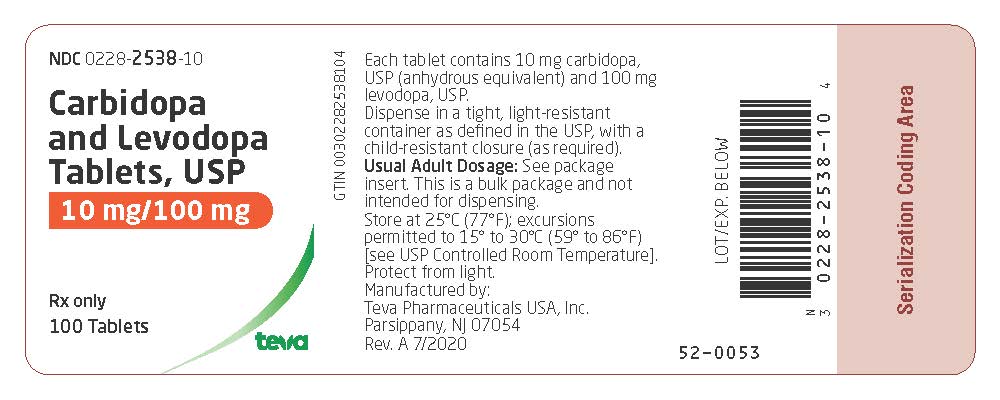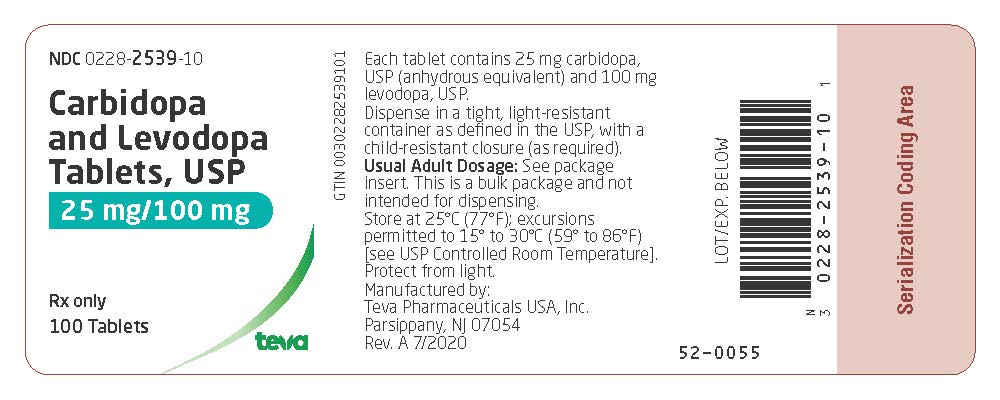Levodopa
Generic name: levodopa inhalation
Brand names: Inbrija, Dopar, Larodopa
Dosage form: inhalation capsule (42 mg)
Drug class: Dopaminergic antiparkinsonism agents
Medically reviewed by A Ras MD.
What is levodopa?
Levodopa is a prescription medicine that is used to treat “off” episodes (when a dose wears off) in people with Parkinson’s disease.
Description
Carbidopa and levodopa extended-release tablets are an extended-release combination of carbidopa and levodopa for the treatment of Parkinson’s disease and syndrome.
Carbidopa, an inhibitor of aromatic amino acid decarboxylation, is a white, crystalline compound, slightly soluble in water, with a molecular weight of 244.24. It is designated chemically as (-)-L-α-hydrazino-α-methyl-β-(3,4-dihydroxybenzene) propanoic acid monohydrate. Its empirical formula is C10H14N2O4•H2O and its structural formula is:

Tablet content is expressed in terms of anhydrous carbidopa, which has a molecular weight of 226.23.
Levodopa, an aromatic amino acid, is a white, crystalline compound, slightly soluble in water, with a molecular weight of 197.2. It is designated chemically as (-)-L-α-amino-β-(3,4-dihydroxybenzene) propanoic acid. Its empirical formula is C9H11NO4 and its structural formula is:

Carbidopa and levodopa extended-release tablets are supplied as extended-release tablets containing 50 mg of carbidopa and 200 mg of levodopa. Inactive ingredients: colloidal silicon dioxide, D&C Yellow No. 10, FD&C Red No. 3, fumaric acid, hypromellose, and sodium stearyl fumarate.
The carbidopa and levodopa extended-release tablet is a polymeric-based drug delivery system that controls the release of carbidopa and levodopa as it slowly erodes. The 50 mg/200 mg half-tablet (bisect) will facilitate a 25 mg/100 mg tablet dose.
Mechanism of Action
Parkinson’s disease is a progressive, neurodegenerative disorder of the extrapyramidal nervous system affecting the mobility and control of the skeletal muscular system. Its characteristic features include resting tremor, rigidity, and bradykinetic movements. Symptomatic treatments, such as levodopa therapies, may permit the patient better mobility.
Current evidence indicates that symptoms of Parkinson’s disease are related to depletion of dopamine in the corpus striatum. Administration of dopamine is ineffective in the treatment of Parkinson’s disease apparently because it does not cross the blood-brain barrier. However, levodopa, the metabolic precursor of dopamine, does cross the blood-brain barrier, and presumably is converted to dopamine in the brain. This is thought to be the mechanism whereby levodopa relieves symptoms of Parkinson’s disease.
Before taking levodopa, tell your doctor:
- If you are allergic to levodopa; any part of this medicine; or any other drugs, foods, or substances. Tell your doctor about the allergy and what signs you had.
- If you have any of these health problems: Asthma or other breathing problems like COPD (chronic obstructive pulmonary disease).
- If you have taken certain drugs used for low mood (depression) like isocarboxazid, phenelzine, or tranylcypromine in the last 14 days. Taking levodopa within 14 days of those drugs can cause very bad high blood pressure.
This is not a list of all drugs or health problems that interact with levodopa.
Tell your doctor and pharmacist about all of your drugs (prescription or OTC, natural products, vitamins) and health problems. You must check to make sure that it is safe for you to take levodopa with all of your drugs and health problems. Do not start, stop, or change the dose of any drug without checking with your doctor.
What are some things I need to know or do while I take levodopa?
- Tell all of your health care providers that you take levodopa. This includes your doctors, nurses, pharmacists, and dentists.
- Avoid driving and doing other tasks or actions that call for you to be alert until you see how levodopa affects you.
- To lower the chance of feeling dizzy or passing out, rise slowly if you have been sitting or lying down. Be careful going up and down stairs.
- This medicine may affect certain lab tests. Tell all of your health care providers and lab workers that you take levodopa.
- Talk with your doctor before you drink alcohol or use other drugs and natural products that slow your actions.
- Some products may cause a dark red, brown, or black color to appear in your saliva, urine, or sweat. This is not harmful but may discolor your clothes.
- Some people have fallen asleep during activities like driving, eating, or talking. Some people did not feel sleepy and felt alert right before falling asleep. This has happened up to 1 year after levodopa was started. If you fall asleep during activities, do not drive or do other tasks or actions that call for you to be alert while you take levodopa. Call your doctor right away if this happens or you feel very sleepy.
- Do not stop taking levodopa all of a sudden or lower your dose without talking to your doctor. Side effects may happen.
- If you are 65 or older, use levodopa with care. You could have more side effects.
- Tell your doctor if you are pregnant, plan on getting pregnant, or are breast-feeding. You will need to talk about the benefits and risks to you and the baby.
How is levodopa best taken?
Use levodopa as ordered by your doctor. Read all information given to you. Follow all instructions closely.
- Use at the first signs you feel your Parkinson’s signs start to come back.
- Only use the device that comes with levodopa. Do not use any other devices.
- Wash your hands before use.
- Be sure your hands are dry before you touch levodopa.
- Take the capsule out of the foil right before use.
- Do not swallow capsule. The contents of the capsule will be breathed into the lungs.
- Do not open the capsules.
- Do not use capsules that are crushed, damaged, or wet.
- Put the cap back on after you are done using your dose.
- Use new inhaler with each refill.
- If you take an iron product or a multivitamin that has iron, ask your doctor or pharmacist how to take it with levodopa. Iron may lower how well your body is able to absorb levodopa.
What do I do if I miss a dose?
- This medicine is used on an as needed basis. Do not use more often than told by the doctor.
What are the side effects of levodopa that I need to call my doctor about immediately?
WARNING/CAUTION: Even though it may be rare, some people may have very bad and sometimes deadly side effects when taking a drug. Tell your doctor or get medical help right away if you have any of the following signs or symptoms that may be related to a very bad side effect:
- Signs of an allergic reaction, like rash; hives; itching; red, swollen, blistered, or peeling skin with or without fever; wheezing; tightness in the chest or throat; trouble breathing, swallowing, or talking; unusual hoarseness; or swelling of the mouth, face, lips, tongue, or throat.
- Trouble breathing that is new or worse.
- Change in the way you act.
- Hallucinations (seeing or hearing things that are not there).
- Feeling confused.
- Feeling agitated.
- Restlessness.
- Trouble sleeping.
- Strange or odd dreams.
- Strong urges that are hard to control (such as eating, gambling, sex, or spending money).
- Trouble controlling body movements that is new or worse.
- Dizziness or passing out.
- Very upset stomach or throwing up.
- Sweating a lot.
- Change in eyesight.
- Eye pain.
What are some other side effects of levodopa?
All drugs may cause side effects. However, many people have no side effects or only have minor side effects. Call your doctor or get medical help if any of these side effects or any other side effects bother you or do not go away:
- Cough.
- Change in color of sputum.
- Signs of a common cold.
- Upset stomach.
These are not all of the side effects that may occur. If you have questions about side effects, call your doctor. Call your doctor for medical advice about side effects.
You may report side effects to the FDA at 1-800-332-1088. You may also report side effects at https://www.fda.gov/medwatch.
If overdose is suspected:
If you think there has been an overdose, call your poison control center or get medical care right away. Be ready to tell or show what was taken, how much, and when it happened.
How do I store and/or throw out levodopa?
- Store at room temperature in a dry place. Do not store in a bathroom.
- Store capsules in the original container. Use right after opening.
- Do not store capsules in the inhaler.
- Keep all drugs in a safe place. Keep all drugs out of the reach of children and pets.
- Throw away unused or expired drugs. Do not flush down a toilet or pour down a drain unless you are told to do so. Check with your pharmacist if you have questions about the best way to throw out drugs. There may be drug take-back programs in your area.
Label
PACKAGE LABEL.PRINCIPAL DISPLAY PANEL
- NDC 0228-2538-10
- Carbidopa and Levodopa Tablets, USP
- 10 mg/ 100 mg
- Rx only
- 100 Tablets

PACKAGE LABEL.PRINCIPAL DISPLAY PANEL

